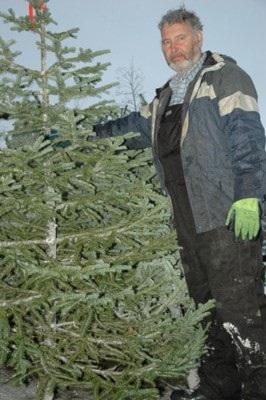Decorating a Christmas tree is for many a revered activity to do with family or friends at this time of year.
It's an event filled with tradition, that sees many sipping cups of hot chocolate, hanging festive decorations and shimmering tinsel from a tree’s branches, maybe wrapping it in lights, or topping it with a star or an angel.
And for some, part of that tradition is finding the perfect tree before it arrives indoors.
In the Terrace area, more than 200 trees are personally selected at the U-Cut Christmas tree farm annually. The farm has been owned by the Coburn family since 1982. It spans 50 acres of land planted with a variety of coniferous trees grown specially for this yearly occasion.
Dad Don Coburn said with a smile that many take time cutting their tree, some hemming and hawing over height, fullness and shape to find the perfect one.
Individual cuts usually begin early December, he said.
And for those who don't travel personally to the farm, U-Cut trees can be found throughout the northwest.
So far, 200 trees grown there have traveled to Smithers, 100 to Dawson Creek, 222 to Prince Rupert, 100 to Prince George and 400 to Terrace, sold by the Terrace Boy Scouts.
But the life cycle of a Christmas tree begins many years before it is cut, poised and decorated.
Coburn said trees are planted eight to ten years before they are cut.
“You need about five acres each year, at least,” he said.
“It's a 10-year cycle.”
The U-Cut farm has 10 different patches of trees which rotate throughout the years, each path being harvested over three years and sometimes even five, explained Coburn.
The farm requires about four months work annually. Four to five days are spent planting, and weeding and pruning occur from July through September. Harvesting begins mid November, this year starting Nov. 16.
Planted at the farm are Grand Fir, Noble Fur, Fraser Fir, Alpine Fir and Amabilis Fir and Douglas Fir.
Red Pine, White Pine and Scotch Pine can also be found there along with Blue Spruce.
To distinguish Fir, Pine and Spruce from one another, the answer lies in the tree’s needles.
Pine needles extend from branches in clumps of two to five depending on the kind.
For example, White Pine trees have five needles per cluster.
Both Fir and Spruce have needles that are attached individually.
To tell the difference, the key is in the needle’s shape.
Fir needles tend to be somewhat blunter than spruce needles, which have a squarish shape.
